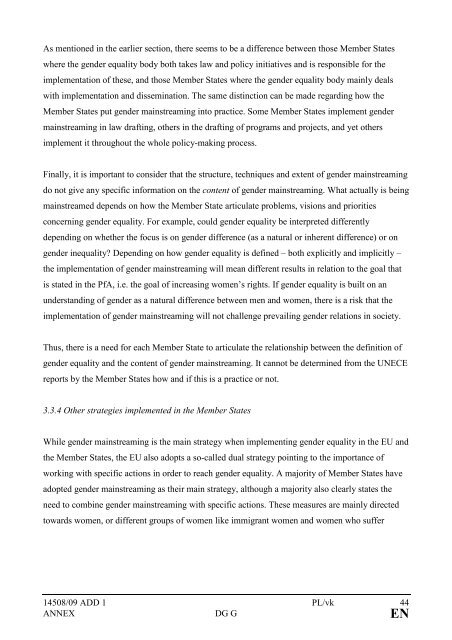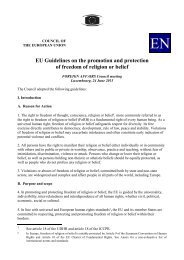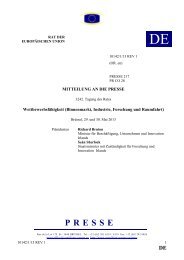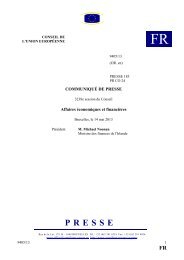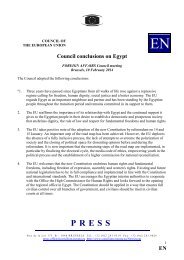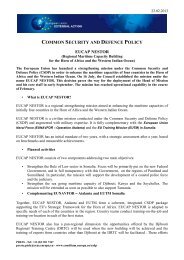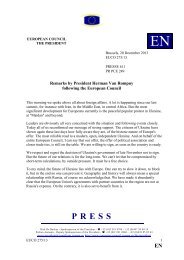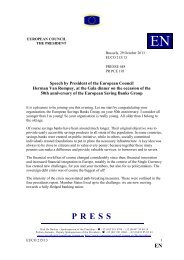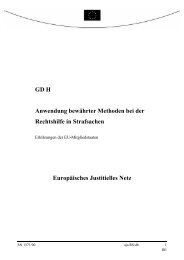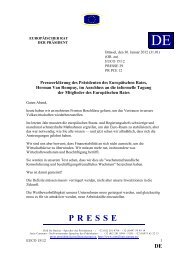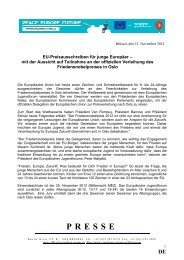14508/09 ADD 1 PL/vk 1 DG G COUNCIL OF THE ... - Europa
14508/09 ADD 1 PL/vk 1 DG G COUNCIL OF THE ... - Europa
14508/09 ADD 1 PL/vk 1 DG G COUNCIL OF THE ... - Europa
Create successful ePaper yourself
Turn your PDF publications into a flip-book with our unique Google optimized e-Paper software.
As mentioned in the earlier section, there seems to be a difference between those Member States<br />
where the gender equality body both takes law and policy initiatives and is responsible for the<br />
implementation of these, and those Member States where the gender equality body mainly deals<br />
with implementation and dissemination. The same distinction can be made regarding how the<br />
Member States put gender mainstreaming into practice. Some Member States implement gender<br />
mainstreaming in law drafting, others in the drafting of programs and projects, and yet others<br />
implement it throughout the whole policy-making process.<br />
Finally, it is important to consider that the structure, techniques and extent of gender mainstreaming<br />
do not give any specific information on the content of gender mainstreaming. What actually is being<br />
mainstreamed depends on how the Member State articulate problems, visions and priorities<br />
concerning gender equality. For example, could gender equality be interpreted differently<br />
depending on whether the focus is on gender difference (as a natural or inherent difference) or on<br />
gender inequality? Depending on how gender equality is defined – both explicitly and implicitly –<br />
the implementation of gender mainstreaming will mean different results in relation to the goal that<br />
is stated in the PfA, i.e. the goal of increasing women’s rights. If gender equality is built on an<br />
understanding of gender as a natural difference between men and women, there is a risk that the<br />
implementation of gender mainstreaming will not challenge prevailing gender relations in society.<br />
Thus, there is a need for each Member State to articulate the relationship between the definition of<br />
gender equality and the content of gender mainstreaming. It cannot be determined from the UNECE<br />
reports by the Member States how and if this is a practice or not.<br />
3.3.4 Other strategies implemented in the Member States<br />
While gender mainstreaming is the main strategy when implementing gender equality in the EU and<br />
the Member States, the EU also adopts a so-called dual strategy pointing to the importance of<br />
working with specific actions in order to reach gender equality. A majority of Member States have<br />
adopted gender mainstreaming as their main strategy, although a majority also clearly states the<br />
need to combine gender mainstreaming with specific actions. These measures are mainly directed<br />
towards women, or different groups of women like immigrant women and women who suffer<br />
<strong>14508</strong>/<strong>09</strong> <strong>ADD</strong> 1 <strong>PL</strong>/<strong>vk</strong> 44<br />
ANNEX <strong>DG</strong> G EN


